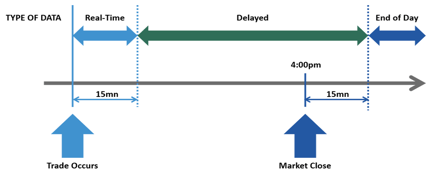Financial Data is Not Free
Understanding Exchange Data Agreements and Fees
If you are building a website or application that requires real-time or delayed exchange data you may be subject to agreements and fees. This issue is complex and changes on a regular basis, and there are lots of exceptions. If you don’t follow the rules you may be subject to SEC regulation and be liable for payment. This information will familiarize you with some key concepts, as well as what to expect.
Key Concepts
By receiving and distributing market data, you become a distributor in the eyes of the exchange. This means that you may have to have an agreement with the exchange and pay fees.
Do I need an Exchange Agreement?
|
You will need an agreement if either:
|
Exceptions:
|
Beware when a vendor says an agreement is not needed. Check with the exchange!
There are exceptions to the rules above: For instance, some exchange-specific or media-only datafeeds do not require end-users to sign user agreements. Also you may not need to sign an agreement or pay datafeed fees for your VOR service provider.
Exchange Agreements
- Are executed directly with exchanges.
- Will define your reporting requirements.
We can initiate the process for you and provide contact information.
KEY CONCEPTS
Why Do I Need to Pay Twice?
WHEN YOU RECEIVE OR DISPLAY DATA
You become a Data Distributor for the exchange.
- Delay (Delayed Quotes / Real-Time Quotes)
-
Depth (Late Sale / BBO / Level 2 / Depth of Book)
-
Breadth (Single Exchange / Consolidated Tape)
-
Source (NYSE / NASDAQ / BATS / etc.)
-
Type of User (Pro / Non-Pro)
-
Usage (Display / Non-Display / Wallboard / Web / etc.)
-
Control (Control of Access / Control of Display)
KEY CONCEPTS
The data choices you make will impact costs.
Understanding market data means understanding the key factors that will affect costs and functionality in your solution.
Delay
- Real-Time data is fee-liable and requires exchange agreements.
- Delayed data is often not fee liable, but licenses may need to be in place either way (ex NASDAQ).
- Historical data is often not fee-liable based on the delay policies, though access to historical data is often fee liable.
Depth
- Last Sale data is generally cheaper than BBO, Depth of Book, or Level 2 data for a given exchange.
Breadth
- Consolidated Tape data is fee liable (CTA, UTP).
- Direct Exchange data or alternative access to consolidated data is priced differently via various models.
- Exchanges can assist you based on your needs.
- Exchange-specific data is priced by each exchange using different pricing models.

What do the terms Delayed
and Real-Time really mean?
- End of Day data is not fee liable in the US (with exceptions like Mutual Fund prices).
- Real-time data is always fee-liable.
Think about what the minimum requirements for your app are.

What depth of quote
information is available?
| Depth is simply the amount of information you get in your data feed. It ranges from only the price of the last sale or trade to details about all outstanding bids and asks and the name of market makers who placed those orders (Level 2 data). |
Depth can impact price as well as your ability to display the data to large user base (e.g. on a public web site). Make sure you determine what you really need. Chances are that Last Sale and BBO are all you need for your app. |
Level 2 is the top BBO from each Market Participant. Some exchanges also offer feeds with every single BBO from each participant at every price (e.g. NASDAQ TotalView). |
KEY CONCEPTS
Consolidated and Exchange-Specific Feeds
Consolidated Feed
- Merges all feeds from all exchanges.
- Price is the latest price on any exchange.
- Volume is consolidated volume across all exchanges.
- Feeds are fee liable and subject to End-User Fees.
Exchange Specific Feeds
- Only includes trades/quotes from that exchange.
- Includes data for stocks listed on other exchanges.
- Price is from last trade on that exchange*.
- Volume is the sum of trades on that exchange.
- Liquidity and coverage vary based on market share.
- Pricing is set by each exchange.
KEY CONCEPTS
Why can I get quotes for NYSE-listed securities from a NASDAQ feed?
About Listing
- The primary listing exchange is the main exchange were a security is bought/sold.
- This is the exchange where the IPO occurs.
- Not all exchanges list (only NYSE, NASDAQ, CHX and BATS do).
About Trading
- Exchanges receive orders from participants.
- Exchanges must by law provide best execution, which means routing orders to other exchanges.
- Market centers can execute orders for securities they do not list. Some are not even the first market center for securities they list.
- This means that exchanges have quotes for securities they do not list.
KEY CONCEPTS
When you display real-time data to users the type of user matters.
Professional Subscriber
Any natural person who is either:
- Registered or qualified in any capacity with the SEC, the CFTC, and other organizations.
- Engaged as an "investment advisor" (whether or not registered or qualified).
- Employed by a bank or other organization exempt from registration to perform functions that would normally require registration or qualification.
Non-Professional Subscriber
Any natural person who is not a professional subscriber.
DO I NEED AN EXCHANGE AGREEMENT
Who needs an Exchange Agreement?
You will need an agreement if either:
- You receive a datafeed.
- You receive real-time data (even as an individual).
Exceptions:
- The data is hosted by another firm (not a datafeed).
- You are a firm receiving only NYSE Delayed Data.
Beware when a vendor says an agreement is not needed. When in doubt, check with the exchange. There are exceptions to the rules above, for instance, some exchange-specific or media-only datafeeds do not require end-users to sign user agreements.
Exchange Agreements
- Are executed directly with exchanges.
- Will define your reporting requirements.
QUODD can initiate the process for you and provide contact information.
DO I NEED AN EXCHANGE AGREEMENT
What is a datafeed?
This is a key concept to determine whether you have to pay fees or not. You get data from a vendor.
Is it a datafeed? You need to answer two simple questions:
- Do you control the display of the data?
- Do you control access or entitlement to the data?
An API is always a datafeed.
Data Feeds
- Continuous Feeds (Sockets, etc).
- REST & SOAP APIs (XML, JSON).
- Files (CSV, Binary).
Non-Data Feeds
- Hosted Widgets.
- Hosted Web Pages.
- Hosted Terminals.
DO I NEED AN EXCHANGE AGREEMENT
Will I Be Subject to Reporting?
This is a key concept to determine whether you have to pay fees or not.
Exchanges require detail reporting for:
- Real-time external professional subscribers.
- Real-time & delayed datafeed recipients.
Exchanges do not require reporting for:
- Delayed internal and external subscribers.
- CBOE requires no user reporting.
Reporting is done monthly using each exchange’s reporting system
- Exchanges bill you based on what you report.
- Exchanges can back-bill you for misreported data!
- Exchange can audit you so follow the rules!
| CLASS | DATA TYPES | CONTENT DETAILS | STATISTICS | REGION |
|---|---|---|---|---|
|
Indices Benchmarks |
Real-Time Data Delayed Data Historical Data |
Intraday Quotes Historical Quotes Intraday Bars |
200,00 Indices 65 Index Groups |
Global |
Advanced API Delivery
QUODD offers several advanced APIs that provide additional delivery options to our suite of market indices APIs.
Cloud Streaming
Stream live stock quotes to a server or directly to mobile and web devices, with just a few lines of code and no infrastructure.
Cloud Add-In
Add real-time stock prices or fundamental data directly to an Excel spreadsheet.
Cloud Search
Give users auto-complete or type-ahead search suggestions for stock symbols, fundamental types, and more.
Related Resources

04.03.2024
|Market Data
|3 Min Read
The Power of Accurate Daily Fund Accruals (MILS)
Daily fund accruals play a crucial role in the comprehensive management and administration of investment funds, ensuring that investors receive equitable and accurate representations of their holdings’ value on a daily basis.

04.17.2024
|Market Data
|5 Min Read
The Power of Daily Security Master Maintenance
Security master maintenance is an essential component of any wealth management platform. QUODD’s security master solution is utilized across various back-office teams including Asset Setup and Management, Fund Accounting, Valuations, Pricing, and Security Operations.

03.05.2024
|Market Data
|3 Min Read
Transparency and Intelligence: The Power of Price Challenges
QX Digital and the Price Viewer application provide users with simplified access to timely information to better understand the market data inputs that go into the creation of an evaluation.